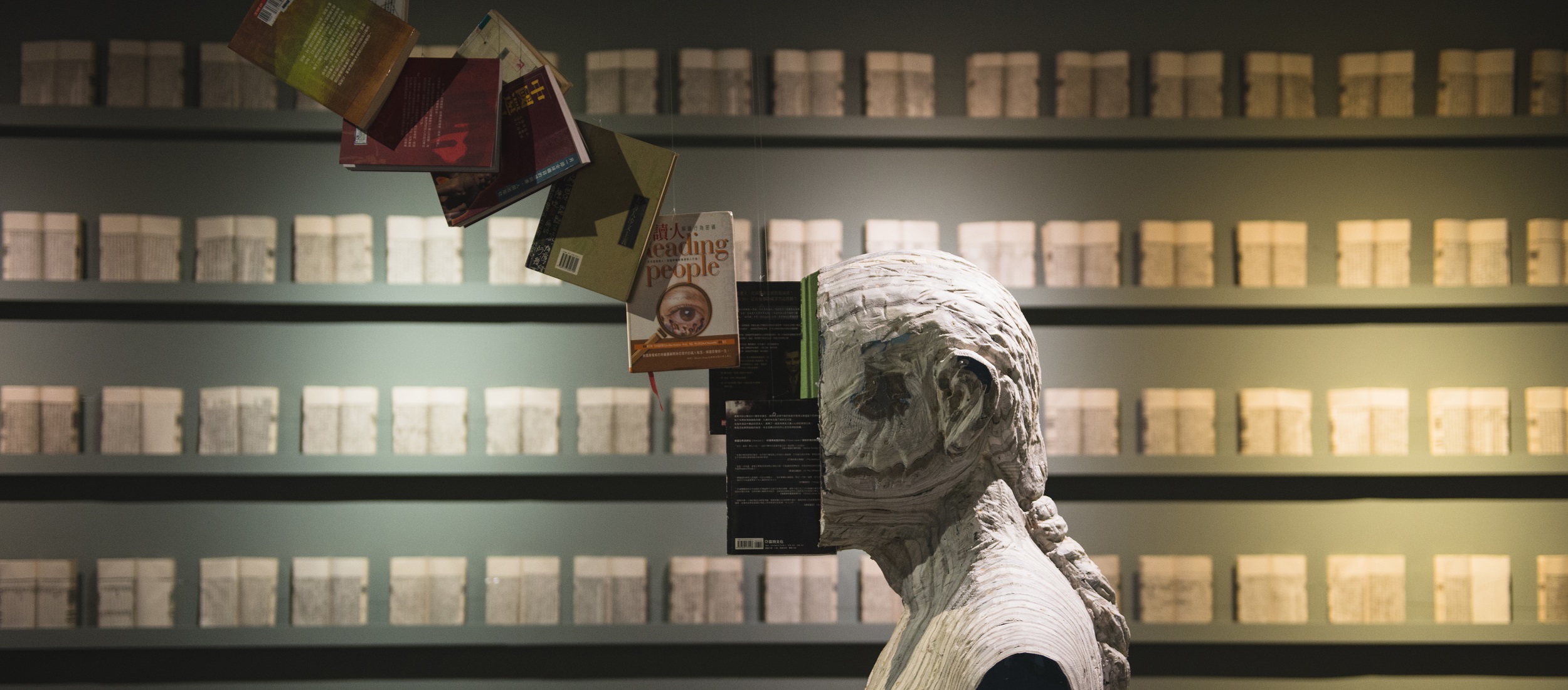

台北當代藝術館 官方網站 Museum of Contemporary Art, Taipei
Friday 星期五
10AM - 6PM



Friday 星期五
10AM - 6PM
EXHIBITIONS & EVENTS 展覽活動

2015 / 02 / 07 Sat.
2015 / 03 / 09 Mon.
10:00 - 18:00
地點
venue
MoCA Studio
每個藝術家都有自己走過的獨特小徑。
【閱讀小徑-陳龍斌書雕個展】是旅美藝術家陳龍斌於台北當代藝術館的首次個展。長期以來,陳龍斌以回收的書籍、雜誌、印表紙為媒材,創作出具有獨特質感與文化內涵的雕塑和藝術裝置,並以此在國際藝壇佔有一席之地。在其精湛的雕刻技術處理下,這些書雕藝術品不論是呈現出木材、大理石等自然質感,或展現一種視覺魔幻效果,都能引人回頭觀想書本與個人成長,乃至與人類文明發展的重要關係,進而思考紙本書籍面對電子時代與數位文化而日漸式微的現象和課題。對陳龍斌而言,這些回收的書籍或淘汰的出版物,既是造型創作的材料也是審美思維的對象,為了賦予這些現成物全新的個性和藝術的生命,他同時從技術和觀念這兩面著手,致力以具體的物質來傳達無形的思想,並立意融合西方的觀念藝術和東方的木刻傳統,從中,他開闢了一條立基於個人價值思維,又能夠切入當代文化現象、呼應國際藝術脈動的創作路線。
【閱讀小徑】這個展名,?引自德國的哲學小徑(philosophenweg),在遠離塵囂、樹蔭濃密的小路上漫步,可讓每個人的內心澄靜有如哲人一般;閱讀經典書籍,公認是知識增長與內化的康莊大道,而閱讀藝術,則彷彿走在一條陡峭曲折的小徑,有時也許空寂孤獨,但也常常會有花開浪漫的喜悅。本次在當代館實驗空間,陳龍斌雕書成石,鋪成了一條貫穿走廊及兩個展間的蜿蜒〈小徑〉,邀請觀眾行走於書石上。這些用書本雕製的「踏腳石」,鋪陳在真實的碎石路面上,帶引觀眾經過兩件書籍雕塑〈眠〉與〈沈思〉,去觀想和對照「身體」暫停前進時,兩種可能的「精神」境界—迷離的夢境或清明的心境。
在左右兩個展間的入口與出口處,各有一個名為〈瘋狂與文明〉的大型懸吊裝置,分別以英文及中文書籍雕製而成,體現中西文明與知識對人類的滋養與轉化。這兩件裝置的形式,基於分解¬<->組合,爆裂<->成型的概念,雙向呈現了一個人類大頭像和一群現成書本之間,在特定時空中相互轉換的戲劇場面和過渡狀態。於此,由回收書本組合雕刻成的兩張激情面容,象徵了人類面對資訊爆炸與多媒體時代的掙扎不安。在這之外,兩個展間內的書架,對照陳列的內容分別是當代書籍與古代善本書籍,類此,觀眾穿梭在東方與西方、傳統與現代之間,感受當代人的閱讀行為,因媒材的科技化轉變到內容、平台的爆量擴充,而邁向一個全新紀元,同時回顧和反思此現代化進程對吾人的衝擊與影響。
Each artist has treaded on his own unique path.
The Reader's Way is the first MoCA solo exhibition of Long-bin Chen, a Taiwanese expatriate artist in America. For a long time, Chen has used recycled books, magazines and printing paper as his chosen material to create sculptures and art installations that possess unique texture and cultural meaning, for which he has been recognized in the international art scene. Processed with his outstanding sculptural techniques, these book sculptures appear to be made of wood or marble, or display fantastic visual effect, making the audience contemplate on the relationships between books and personal growth as well as the development of civilization. The audience would further think about the phenomenon and issue of how physical books have become less dominant in the electronic age of digital culture. For Chen, these recycled books or disposed publications are both material for sculptural art and aesthetic subjects to ponder upon. In order to give new characteristics and artistic life to these objects, he tackles the subject from the aspects of both technique and artistic concept, committing to the task of delivering intangible ideas through physical matter. He intentionally incorporates Western conceptual art and Eastern wood carving tradition, and opens up a new creative path that is founded on his personal values and philosophy while addressing the phenomena in contemporary culture and responding to international art trends.
The title of the exhibition is inspired by the German term, philosophenweg (path of philosophy), which refers to the experience of walking on a leafy path far away from the boisterous world. There, the walker could submerge in tranquility like a philosopher. Reading canonical works is considered to be the best way to accumulate and internalize knowledge. Reading art, on the other hand, is like hiking on a winding, precipitous path, which might be a lonely experience blessed with occasional joy of floral blossoms. This time, in the space of MoCA Studio, Chen has chiseled books into stones, paved a winding Reader’s Way that connects the corridor and two gallery rooms. He invites the audience to walk on the book stones; and these “stepping stones” sculpted from books are placed on a real gravel path, leading the audience to two book sculptures, Sleep and Meditate, that encourage us to contemplate and observe two possible “spiritual” realms when our “body” pause from moving forward—the misty, hazy dream or the clear, bright state of mind.
At the entrance and exit of the galleries, there are two large installations suspended in midair, entitled Crazy and Civilization. They are individually made of English and Chinese books, embodying the nurturance and influence of Western and Eastern civilizations and knowledge. These installations adopt the concepts of deconstruction and composition as well as disintegration and formation, representing in duality a dramatic inter-transformation and transition between a large human head and a group of books. The two emotional faces created with recycled books symbolize the struggle and anxiety of mankind when faced with the explosion of information and the era of excessive media. In addition to the installations, the bookshelves in the two rooms display contemporary books and ancient rare books. Thus, visitors would walk in between the East and the West as well as the traditional and the modern, witnessing how modern people’s reading behavior is transfigured with the explosion and expansion of contents and platforms due to the technologized media, and resultantly, ventures into a brand new era; it is also a good chance to examine and reflect upon the impact and influence of such modern progress.
MORE
LESS
陳龍斌出生在台灣。台中東海大學美術系學士,美國紐約視覺藝術學院碩士,現定居美國紐約。他的作品曾在美國、德國、荷蘭、義大利、巴西、印度、台灣、新加坡、韓國、日本和香港展出。重要的展出包括:美國麻州當代兒童藝術館、荷蘭紙藝雙年展、德國新媒體中心、古巴哈瓦那雙年展、紐約藝術與設計美術館、耶魯大學藝廊等。
Long-Bin Chen was born in Taiwan. He received a BFA from Tung-Hai University in Taiwan and an MFA from the School of Visual Arts in New York. He currently lives and works in New York. He has exhibited widely in the United States, Germany, Netherland, Italy, Brazil, India, Taiwan, Singapore, Korea, Japan, and Hong Kong. His most recent important exhibitions include kidspace at Mass MOCA in Massachusetts, Holland Paper Biennial, ZKM- Center for Art and Media in German, Havana Biennial, Museum of Art & Design in New York, and Yale University Art Gallery, etc.
CLOSE
CLOSE
著作權聲明
台北當代藝術館尊重他人著作權,台北當代藝術館服務條款亦明定,網友使用台北當代藝術館服務不得侵害他人之著作權,因此,台北當代藝術館呼籲使用者同樣尊重他人之著作權。如果您認為台北當代藝術館網站中之任何網頁內容或網友使用台北當代藝術館服務已侵害您的著作權,建議您利用本處理辦法提出檢舉,台北當代藝術館客服中心將儘速為您處理:
若台北當代藝術館網站中之任何網頁內容或網友使用台北當代藝術館服務已侵害您的著作權,請您填寫:「 著作權侵權通知書」,且依該通知書所載提供下列資料及聲明,並以傳真的方式通知台北當代藝術館:
1、著作權人之簽名、或著作權人之代理人之簽名、相關權利證明文件及著作權之內容,例如:已發行書籍之封面及相關頁面、發表於網路中之網頁內容列印紙本及其網址。
2、侵害著作權之內容所在的網頁及網址。
3、您的聯絡地址、電話等資料。
4、書面聲明您確信該網頁內容的使用行為是未經過著作權人、其代理人或法律的授權。
5、書面聲明您於通知書所載相關資料均為真實,且您是著作權人或著作權人之代理人而為上開聲明。
若台北當代藝術館網站中之任何網頁內容或網友使用台北當代藝術館服務已侵害您的著作權,請您填寫:「 著作權侵權通知書」,且依該通知書所載提供下列資料及聲明,並以傳真的方式通知台北當代藝術館:
1、著作權人之簽名、或著作權人之代理人之簽名、相關權利證明文件及著作權之內容,例如:已發行書籍之封面及相關頁面、發表於網路中之網頁內容列印紙本及其網址。
2、侵害著作權之內容所在的網頁及網址。
3、您的聯絡地址、電話等資料。
4、書面聲明您確信該網頁內容的使用行為是未經過著作權人、其代理人或法律的授權。
5、書面聲明您於通知書所載相關資料均為真實,且您是著作權人或著作權人之代理人而為上開聲明。
隱私權保護政策
台北當代藝術館非常重視用戶的隱私權,因此制訂了隱私權保護政策。請你細讀以下有關隱私權保護政策的內容。
隱私權保護政策的適用範圍
1、隱私權保護政策內容,包括台北當代藝術館如何處理在用戶使用網站服務時收集到的身份識別資料,也包括台北當代藝術館如何處理在商業伙伴與台北當代藝術館合作時分享的任何身份識別資料。
2、隱私權保護政策不適用於台北當代藝術館以外的公司,也不適用於非台北當代藝術館所僱用或管理的人員。
3、台北當代藝術館在你註冊台北當代藝術館帳號、使用台北當代藝術館的產品或服務、瀏覽台北當代藝術館網頁、參加宣傳活動或贈獎遊戲時,台北當代藝術館會收集你的個人識別資料。台北當代藝術館也可以從商業夥伴處取得個人資料。
4、當你在台北當代藝術館註冊時,我們會問及你的姓名、電子郵件地址、出生日期、性別、職位、行業及個人興趣等資料。你在台北當代藝術館註冊成功,並登入使用我們的服務後,我們就會認識你。
5、台北當代藝術館也自動接收並紀錄你瀏覽器上的伺服器數值,包括互聯網協定位址 (IP Address) 、台北當代藝術館cookie中的資料及你要求取用的網頁紀錄。
6、台北當代藝術館會使用資料作以下用途:改進為你提供的廣告及網頁內容、完成你對某項產品的要求及通知你特別活動或新產品。
7、台北當代藝術館不會向任何人出售或出借你的個人識別資料。
8、在以下的情況下,台北當代藝術館會向政府機關、其他人士或公司提供你的個人識別資料:與其他人士或公司共用資料前取得你的同意。
9、需要與其他人士或公司共用你的資料,才能夠提供你要求的產品或服務。
10、向代表台北當代藝術館提供服務或產品的公司提供資料,以便向你提供產品或服務 (若我們沒有事先通知你,這些公司均無權使用我們提供的個人資料,作提供產品或服務以外的其他用途)。
11、應遵守法令或政府機關的要求。
12、我們發覺你在網站上的行為違反 台北當代藝術館服務條款或產品、服務的特定使用指南。
13、其他依「個人資料保護法」或政府法令應公開之資料。
14、為了保護使用者個人隱私, 我們無法為您查詢其他使用者的帳號資料,請您見諒!若您有相關法律上問題需查閱他人資料時,請務必向警政單位提出告訴,我們將全力配合警政單位調查並提供所有相關資料,以協助調查及破案!
15、 台北當代藝術館會到你的電腦設定並取用台北當代藝術館cookie。
16、台北當代藝術館容許在我們網頁上擺放廣告的廠商到你的電腦設定並取用cookie。其他公司將根據其自訂的隱私權保護政策,而並非本政策使用其cookie。其他廣告商或公司不能提取台北當代藝術館的cookie。
17、當台北當代藝術館進行與其產品及服務有關的工作時,會使用 web beacons 進入我們的網站網絡,提取cookie使用。
18、台北當代藝術館賦予你在任何時候修改個人台北當代藝術館帳號資料及偏好設定的權力,包括接受台北當代藝術館通知你特別活動或新產品的決定權。